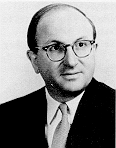Wilbur J. Cohen
 |
WILBUR J. COHEN Wilbur Cohen, formerly HEW Secretary in 1968-69, served as technical advisor to the Commissioner of Social Security from 1935 to 1952. Previously, he was research assistant to the Executive Director of President Roosevelt's Committee on Economic Security, 1934-35, which drew up the original Social Act.
|
In 5 short months in 1934 the basic framework of the Social Security Act was formulated. And in another 7 months in 1935 it was enacted into law!A monumental change in the relationships between individuals, the States, and the Federal Government had been instituted. Today, 50 years later, we can see the significance and magnitude of that historic legislation in protecting families, communities, and the Nation. Shortly after President Roosevelt signed the Social Security bill into law on August 14, 1935, he appointed three members of the newly established Social Security Board. To demonstrate that the new law was to be administered impartially and non-politically he appointed a former Republican Governor of New Hampshire, John G. Winant, as the Chairman of the Board. Arthur J. Altmeyer, the Chairman of the Technical Board of the Committee on Economic Security, who had had primary responsibility with Frances Perkins, in making the major policy recommendations was appointed a member of the Board. Within a few hours of his appointment, Mr. Altmeyer telephoned me and asked me to bring my papers, a typewriter, and our secretary, to an office on the third floor of the Department of Labor where we started the Social Security Board. I was the first professional employee of the Board. I recall the anxiety we experienced in late 1936 when we began to register persons for their Social Security numbers. The registration of some 26 million persons was a major project which we thought might swamp the post office. Some newspapers raised the fear that the registration form might be an invasion of privacy and lead to regimentation of those enrolled. But the good sense of the American people overcame these unfounded fears. One of our major tasks in 1936-37 was to develop publish and distribute informational pamphlets on all aspects of the new and far-reaching law. The pamphlet on old-age "benefits" (title II) was so simple and clear that the New Yorker magazine publicly heralded it as a triumph of clarity and simplicity. Over the years the Social Security Administration has pioneered in preparing and distributing public information of outstanding quality to beneficiaries and contributors. I was present in the Supreme Court on May 24, 1937 with John Winant and Arthur Altmeyer when Justice Benjamin N. Cardozo handed down the three decisions which upheld the constitutionality of the Federal old-age insurance aspect of Social Security (7 to 2) and State unemployment insurance laws (5 to 4). We walked down the steps of the Supreme Court building in an euphoric glow. A new day had dawned in American constitutional history. I recall Cardozo's words of 48 years ago as though they were yesterday. He wrote and spoke in poetic cadence: "Nor is the concept of the general welfare static. Needs that were narrow or parochial a century ago may be interwoven in our day with the well-being of the Nation. What is critical or urgent changes with the times . . . The hope behind this statute is to save men and women from the rigors of the poor house as well as the haunting fear that such a lot awaits them when journey's end is near." (Helvering v. Davis, 301 u.s. 641). Old-age, survivors, and disability insurance is what most people think of as "social security." It is the largest program in the Social Security Act--37 million persons are currently drawing benefits--and is an essential part of the safety net in our Nation. Without it there would be more than 15 million persons in the poverty group today and many more persons on welfare. The disability and survivors insurance protection is especially valuable to younger persons and families. The four different types of protection offers a family protection package: disability, life (survivors) insurance, old-age benefits, and Medicare. And administrative costs are only 1.5 percent of the benefits! I recall the time in 1936 when Mr. Winant, the first Chairman of the Social Security Board, and Mr. Altmeyer, later the Commissioner for Social Security, personally selected each and every one of the initial field office managers. They wanted the local offices to serve the public efficiently, effectively, and courteously--as the offices have tried to do since they first opened 49 years ago. I spent 30 years working for the Social Security Board and with the Social Security Administration. The employees were--and still are--a dedicated and competent group of governmental associates. They worked hard and long. I am glad to have been associated with such an important program. I am proud of having had a small role over 50 years in building and preserving a safety net which has helped to reduce the need for welfare and has helped to stabilize purchasing power of our free competitive market economy. |
|